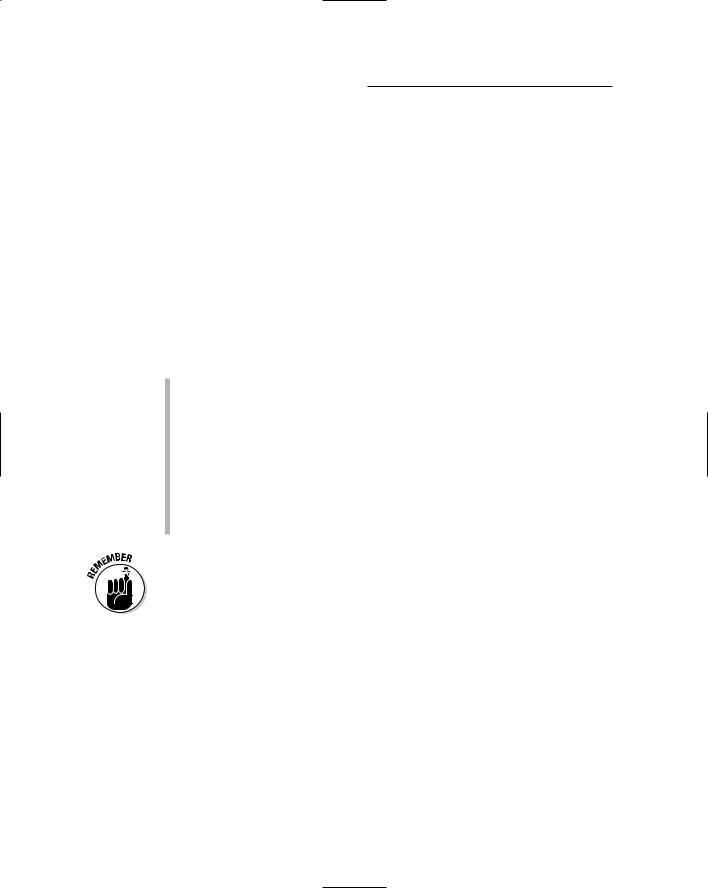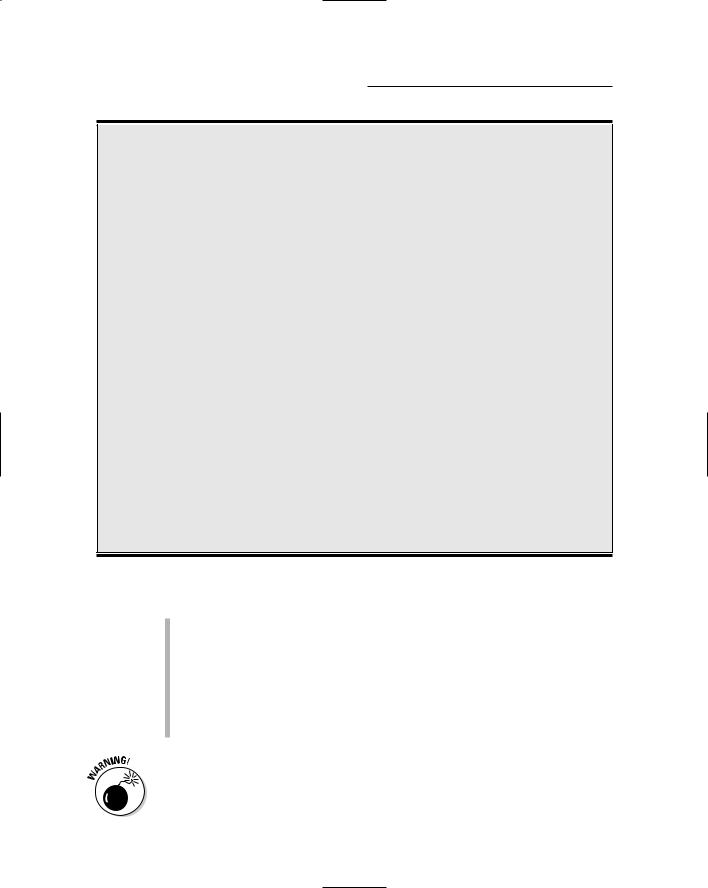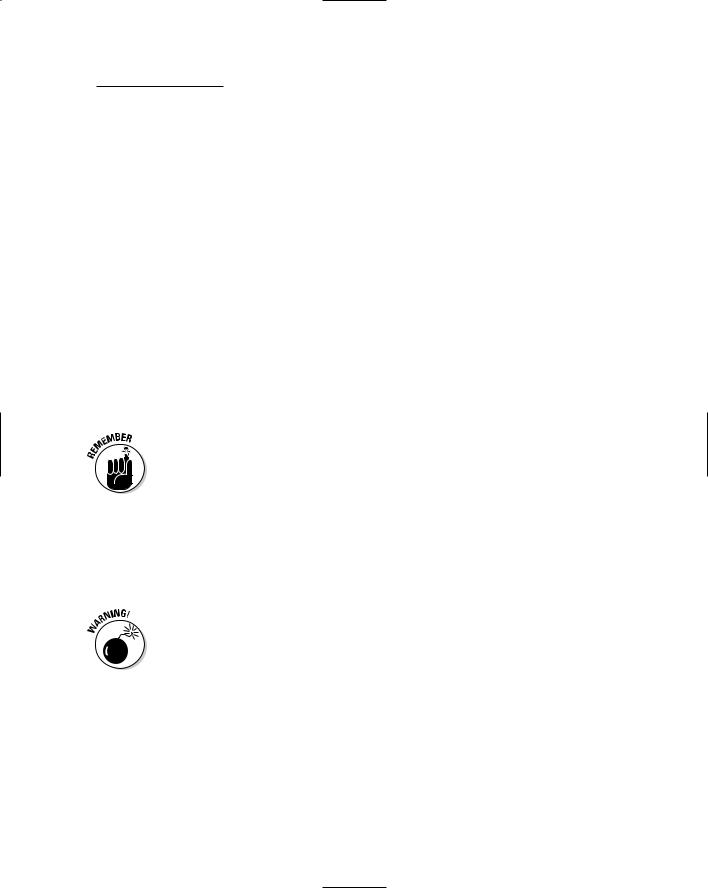
Accounting For Dummies, 4th edition
.pdf
110 Part II: Figuring Out Financial Statements
The “correct” average inventory holding period varies from industry to industry. In some industries, especially heavy equipment manufacturing, the inventory holding period is very long — three months or longer. The opposite is true for high-volume retailers, such as retail supermarkets, that
depend on getting products off the shelves as quickly as possible. The 88-day average holding period in the example is reasonable for many businesses but would be too high for some businesses.
The managers should know what the company’s average inventory holding period should be — they should know what the control benchmark is for the inventory holding period. If inventory is much above this control benchmark, managers should take prompt action to get inventory back in line (which is easier said than done, of course). If inventory is at abnormally low levels, this should be investigated as well. Perhaps some products are out of stock and should be immediately restocked to avoid lost sales.
Fixed assets and depreciation expense
As Chapter 4 explains, depreciation is a relatively unique expense. Depreciation is like other expenses in that all expenses are deducted from sales revenue to determine profit. Other than this, however, depreciation is very different from other expenses. When a business buys or builds a longterm operating asset, the cash outlay for the asset is recorded in a fixed asset account. The cost of a fixed asset is spread out, or allocated, over its expected useful life to the business. The depreciation expense recorded in the period does not require any further cash outlay during the period. (The cash outlay occurred when the fixed asset was acquired.) Rather, depreciation expense for the period is that portion of the total cost of a business’s fixed assets that is allocated to the period to record the cost of using the assets during the period. Depreciation depends on which method is used to allocate the cost of fixed assets over their estimated useful lives. I explain different depreciation methods in Chapter 7.
The higher the total cost of its fixed assets (called property, plant, and equipment in a formal balance sheet), the higher a business’s depreciation expense. However, there is no standard ratio of depreciation expense to the cost of fixed assets. The annual depreciation expense of a business seldom is more than 10 to 15 percent of the original cost of its fixed assets. Either the depreciation expense for the year is reported as a separate expense in the income statement (as in Figure 5-3), or the amount is disclosed in a footnote.
Because depreciation is based on the gradual charging off, or writing-down of, the cost of a fixed asset, the balance sheet reports not one but two numbers: the original (historical) cost of its fixed assets and the accumulated depreciation amount (the total amount of depreciation that has been charged to expense from the time of acquiring the fixed assets to the current balance

Chapter 5: Reporting Assets, Liabilities, and Owners’ Equity 111
sheet date). The purpose isn’t to confuse you by giving you even more numbers to deal with. Seeing both numbers gives you an idea of how old the fixed assets are and also tells you how much these fixed assets originally cost.
In the example we’re working with in this chapter, the business has, over several years, invested $12,450,000 in its fixed assets (that it still owns and uses), and it has recorded total depreciation of $6,415,000 through the end of the most recent fiscal year, December 31, 2009. (Refer to the balance sheet presented in Figure 5-2.) The business recorded $775,000 depreciation expense in its most recent year. (See its income statement in Figure 5-3.)
You can tell that the company’s collection of fixed assets includes some old assets because the company has recorded $6,415,000 total depreciation since assets were bought — a fairly sizable percent of original cost (more than half). But many businesses use accelerated depreciation methods that pile up a lot of the depreciation expense in the early years and less in the back years (see Chapter 7 for more details), so it’s hard to estimate the average age of the company’s assets. A business could discuss the actual ages of its fixed assets in the footnotes to its financial statements, but hardly any businesses disclose this information — although they do identify which depreciation methods they are using.
SG&A expenses and their three balance sheet accounts
Take yet another look at Figure 5-3 and notice that sales, general, and administrative (SG&A) expenses connect with three balance sheet accounts: prepaid expenses, accounts payable, and accrued expenses payable. The broad SG&A expense category includes many different types of expenses in making sales and operating the business. (Separate expense accounts are maintained for specific expenses; depending on the size of the business and the needs of its various managers, hundreds or thousands of specific expense accounts are established.)
For bookkeeping convenience, a business records many expenses when the expense is paid. For example, wage and salary expenses are recorded on payday. However, this “record as you pay” method does not work for many expenses. For instance, insurance and office supplies costs are prepaid, and then released to expense gradually over time. The cost is initially put in the prepaid expenses asset account. (Yes, I know that “prepaid expenses” doesn’t sound like an asset account, but it is.) Other expenses are not paid until weeks after the expenses are recorded. The amounts owed for these unpaid expenses are recorded in an accounts payable or in an accrued expenses payable liability account.

112 Part II: Figuring Out Financial Statements
I won’t go through all the details of how I came up with the year-end balances in prepaid expenses, accounts payable, and accrued expenses payable (aren’t you lucky!). For more details, you may want to take a look at Chapter 4.
Remember that the accounting objective is to match expenses with sales revenue for the year, and only in this way can the amount of profit be measured for the year. So expenses recorded for the year should be the correct amounts, regardless of when they’re paid.
Intangible assets and amortization expense
Although our business example does not include these kinds of assets, many businesses invest in intangible assets. Intangible means without physical existence, in contrast to buildings, vehicles, and computers. For example:
A business may purchase the customer list of another company that is going out of business.
A business may buy patent rights from the inventor of a new product or process.
A business may buy another business lock, stock, and barrel and may pay more than the total of the individual assets of the company being bought are worth — even after adjusting the particular assets to their current values. The extra amount is for goodwill, which may consist of a trained and efficient workforce, an established product with a reputation for high quality, or a very valuable location.
Only intangible assets that are purchased are recorded by a business. A business must expend cash, or take on debt, or issue owners’ equity shares for an intangible asset in order to record the asset on its books. Building up a good reputation with customers or establishing a well-known brand is not recorded as an intangible asset. You can imagine the value of Coca-Cola’s brand name, but this “asset” is not recorded on the company’s books. (However, Coca-Cola protects its brand name with all the legal means at its disposal.)
The cost of an intangible asset is put in the appropriate asset account, just like the cost of a tangible asset is recorded in a fixed asset account. And, like a fixed asset account (with the exception of land), the cost of an intangible asset that has a limited useful economic life is allocated over its estimated useful life. (Note: Certain intangible assets are viewed as having more or less perpetual useful lives.) The allocation of the cost of an intangible asset over its estimated economic life is called amortization. Amortization expense is very similar to depreciation expense. Because our business example does not include any intangible assets, there is no amortization expense.

Chapter 5: Reporting Assets, Liabilities, and Owners’ Equity 113
What about cash?
A business’s cash account consists of the money it has in its checking accounts plus the money that it keeps on hand. Cash is the essential lubricant of business activity. Sooner or later, virtually all business transactions pass through the cash account.
Every business needs to maintain a working cash balance as a buffer against fluctuations in day-to-day cash receipts and payments. You can’t really get by with a zero cash balance, hoping that enough customers will provide enough cash to cover all the cash payments that you need to make that day.
At year-end 2009, the cash balance of the business whose balance sheet is presented in Figure 5-2 is $2,165,000, which equals a little
more than four weeks of annual sales revenue. How large a cash balance should a business maintain? This question has no simple answer. A business needs to determine how large a cash safety reserve it’s comfortable with to meet unexpected demands on cash while keeping the following points in mind:
Excess cash balances are unproductive and don’t earn any profit for the business.
Insufficient cash balances can cause the business to miss taking advantage of opportunities that require quick action — such as snatching up a prized piece of real estate that just came on the market or buying out a competitor.
Debt and interest expense
Look back at the balance sheet shown in Figure 5-2. Notice that the sum of this business’s short-term (current) and long-term notes payable at year-end 2009 is $6.25 million. From its income statement in Figure 5-3 we see that its interest expense for the year was $400,000. Based on the year-end amount of debt, the annual interest rate is about 6.4 percent. (The business may have had more or less borrowed at certain times during the year, of course, and the actual interest rate depends on the debt levels from month to month.)
For most businesses, a small part of their total annual interest is unpaid at year-end; the unpaid part is recorded to bring interest expense up to the correct total amount for the year. In Figure 5-3, the accrued amount of interest is included in the accrued expenses payable liability account. In most balance sheets you don’t find accrued interest payable on a separate line; rather, it’s included in the accrued expenses payable liability account. However, if unpaid interest at year-end happens to be a rather large amount, or if the business is seriously behind in paying interest on its debt, it should report the accrued interest payable as a separate liability.

114 Part II: Figuring Out Financial Statements
Income tax expense and income tax payable
In Figure 5-3, earnings before income tax — after deducting interest and all other expenses from sales revenue — is $2.6 million. The actual taxable income of the business for the year probably is different than this amount because of the many complexities in the income tax law. In the example, I use a realistic 35 percent tax rate, so the income tax expense is $910,000 of the pretax income of $2.6 million.
A large part of the federal income tax amount for the year must be paid before the end of the year. But a small part is usually still owed at the end of the year. The unpaid part is recorded in the income tax payable liability account, as you see in Figure 5-3. In the example, the unpaid part is $115,000
of the total $910,000 income tax for the year, but I don’t mean to suggest that this ratio is typical. Generally, the unpaid income tax at the end of the year is fairly small, but just how small depends on several technical factors.
Net income and cash dividends (if any)
A business may have other sources of income during the year, such as interest income on investments. In this example, however, the business has only sales revenue, which is gross income from the sale of products and services. All expenses — starting with cost of goods sold down to and including income tax — are deducted from sales revenue to arrive at the last, or bottom, line of the income statement. The preferred term for bottom-line profit is net income, as you see in Figure 5-3.
The $1.69 million net income for the year increases the owners’ equity account retained earnings by the same amount, which is indicated by the line of connection from net income to retained earnings in Figure 5-3. The $1.69 million profit (here I go again using the term profit instead of net income) either stays in the business or some of it is paid out and divided among the owners of the business. This business paid out cash distributions from profit during the year, and the total of these cash payments to its owners (shareholders) is recorded as a decrease in retained earnings. You can’t tell from the income statement or the balance sheet the amount of cash dividends. You have to look in the statement of cash flows for this information (which I explain in Chapter 6).

Chapter 5: Reporting Assets, Liabilities, and Owners’ Equity 115
Financing a Business
To run a business, you need financial backing, otherwise known as capital. In broad overview, a business raises capital needed for its assets by buying things on credit, waiting to pay some expenses, borrowing money, getting owners to invest money in the business, and making profit that is retained in the business. Borrowed money is known as debt; capital invested in the business by its owners and retained profits are the two sources of owners’ equity.
How did the business whose balance sheet is shown in Figure 5-2 finance its assets? Its total assets are $14.85 million at year-end 2009. The company’s profit-making activities generated three liabilities — accounts payable, accrued expenses payable, and income tax payable — and in total these three liabilities provided $1.78 million of the total assets of the business. Debt provided $6.25 million, and the two sources of owners’ equity provided the other $6.82 million. All three sources add up to $14.85 million, which equals total assets, of course. Otherwise, its books would be out of balance, which is a definite no-no.
Accounts payable, accrued expenses payable, and income tax payable are short-term, non-interest-bearing liabilities that are sometimes called
spontaneous liabilities because they arise directly from a business’s expense activities — they aren’t the result of borrowing money but rather are the result of buying things on credit or delaying payment of certain expenses.
It’s hard to avoid these three liabilities in running a business; they are generated naturally in the process of carrying on operations. In contrast, the mix of debt (interest-bearing liabilities) and equity (invested owners’ capital and retained earnings) requires careful thought and high-level decisions by a business. There’s no natural, or automatic, answer to the debt-versus-equity question. The business in the example has a large amount of debt relative to its owners’ equity, which would make many business owners uncomfortable.
Debt is both good and bad, and in extreme situations it can get very ugly. The advantages of debt are:
Most businesses can’t raise all the capital they need from owners’ equity sources, and debt offers another source of capital (though, of course, many lenders are willing to provide only part of the capital that a business needs).
Interest rates charged by lenders are lower than rates of return expected by owners. Owners expect a higher rate of return because they’re taking a greater risk with their money — the business is not required to pay them back the same way that it’s required to pay back a lender. For example, a business may pay 6 percent annual interest on its debt and be expected to earn a 12 percent annual rate of return on its owners’ equity. (See Chapter 13 for more on earning profit for owners.)

116 Part II: Figuring Out Financial Statements
Financial leverage: Taking a chance on debt
The large majority of businesses borrow money to provide part of the total capital needed for their assets. The main reason for debt is to close the gap between how much capital the owners can come up with and the amount the business needs. Lenders are willing to provide the capital because they have a senior claim on the assets of the business. Debt has to be paid back before the owners can get their money out of the business. A business’s owners’ equity provides a relatively permanent base of capital and gives its lenders a cushion of protection.
The owners use their capital invested in the business as the basis to borrow. For example, for every two bucks the owners have in the business, lenders may be willing to add another dollar (or even more). Using owners’ equity as the basis for borrowing is referred to as financial leverage, because the equity base of the business can be viewed as the fulcrum, and borrowing is the lever for lifting the total capital of the business.
A business can realize a financial leverage gain by making more EBIT (earnings before interest
and income tax) on the amount borrowed than the interest on the debt. For a simple example, assume that debt supplies one-third of the total capital of a business (and owners’ equity twothirds). Suppose the business’s EBIT for the year just ended is a nice, round $3 million. Fair is fair, so you could argue that the lenders, who put up one-third of the money, should get one-third, or $1 million, of the profit. This is not how it works. The lenders get only the interest amount on their loans. Suppose the total interest for the year is $600,000. The financial leverage gain, therefore, is $400,000. The owners would get their two-thirds share of EBIT plus the $400,000 pretax financial leverage gain.
On the flip side, using debt may not yield a financial leverage gain, but rather a financial leverage loss. One-third of a company’s EBIT may equal less than the interest due on its debt. That interest has to be paid no matter what amount of EBIT the business earns. Suppose EBIT equals zero for the year. Nevertheless, the business must pay the interest on its debt. So, the business would have a bottom-line loss for the year.
The disadvantages of debt are:
A business must pay the fixed rate of interest for the period even if it suffers a loss for the period or earns a lower rate of return on its assets.
A business must be ready to pay back the debt on the specified due date, which can cause some pressure on the business to come up with the money on time. (Of course, a business may be able to roll over or renew its debt, meaning that it replaces its old debt with an equivalent amount of new debt, but the lender has the right to demand that the old debt be paid and not rolled over.)
If a business defaults on its debt contract — it doesn’t pay the interest on time or doesn’t pay back the debt on the due date — it faces some major unpleasantness. In extreme cases, a lender can force it to shut down and liquidate its assets (that is, sell off everything it owns for cash) to pay off the

Chapter 5: Reporting Assets, Liabilities, and Owners’ Equity 117
debt and unpaid interest. Just as you can lose your home if you don’t pay your home mortgage, a business can be forced into involuntary bankruptcy if it doesn’t pay its debts. A lender may allow the business to try to work out its financial crisis through bankruptcy procedures, but bankruptcy is a nasty affair that invariably causes many problems and can really cripple a business.
Costs and Other Balance Sheet Values
In my experience, the values for assets reported in a balance sheet can be a source of confusion for both business managers and investors, who tend to put all dollar amounts on the same value basis. In their minds, a dollar is a dollar, whether it’s in accounts receivable, inventory, fixed assets, accounts payable, or retained earnings. However, this naïve assumption glosses over important differences and can lead to serious misinterpretation of the balance sheet. A balance sheet reports a rainbow of values — not just one color. This is the nature of the generally accepted accounting principles (GAAP) — the accounting methods used to prepare financial statements for the external financial reporting by a business (see Chapter 2).
Book values are the amounts recorded in the accounting process and reported in financial statements. Do not assume that the book values reported in a balance sheet necessarily equal the current market values. Book values are based on the accounting methods used by a business. Generally speaking, the amounts reported for cash, accounts receivable, and liabilities are equal to or are very close to their current market or settlement values. For example, accounts receivable will be turned into cash for the amount recorded on the balance sheet, and liabilities will be paid off at the amounts reported in the balance sheet. It’s the book values of inventory and fixed assets, as well as any other assets in which the business invested some time ago, that most likely are lower than current replacement values.
Different businesses select different accounting methods to determine their cost of inventory and how much of each of their fixed assets’ costs are allocated to depreciation expense each year. A business is free to use very conservative accounting methods — with the result that its inventory cost value and the undepreciated cost of its fixed assets may be considerably lower than the current replacement cost values of these assets. Chapter 7 explains about choosing from among alternative accounting methods.
A business may use accounting methods that have the effect of recording higher profit and higher asset values than would exist under more conservative accounting methods. Even so, the current replacement values of its inventory and fixed assets may be quite a bit higher than the recorded costs of these assets, in particular for buildings, land, heavy machinery, and equipment. For example, the aircraft fleet of United Airlines, as reported in its balance sheet, is

118 Part II: Figuring Out Financial Statements
hundreds of millions of dollars less than the current cost it would have to pay to replace the planes. Complicating matters is the fact that many of its older planes are not being produced any more, and United would replace the older planes with newer models.
Businesses are not permitted under GAAP to write up the book values of their assets to current market or replacement values. (Well, investments in marketable securities held or available for sale have to be written up, or down, but this is an exception to the general rule.) Although recording market values has intuitive appeal, a mark-to-market valuation model is not practical or appropriate for businesses that sell products and services. These businesses do not stand ready to sell their assets (other than inventory); they need their assets for operating the business into the future. At the end of their useful lives, assets are sold for their disposable values (or traded in for new assets).

Chapter 6
Reporting Cash Flows
In This Chapter
Earning profit versus generating cash flow
Presenting the statement of cash flows
Analyzing the cash flow from making profit
Scrutinizing the statement of cash flows
Suppose that a business’s cash balance decreases $110,000 during the year. You see this decrease in the company’s balance sheets for the
years ended December 31, 2008 and 2009. The business started the year with $2,275,000 cash and ended the year with $2,165,000 (as in the business example I use in Chapters 4 and 5.) What does the balance sheet tell you about the reasons for the cash decrease? Well, not a whole lot. Answering such a question is not the nature or purpose of a balance sheet.
One possibility is that the business suffered a large loss in 2009 that caused a drain on cash. You can look at its 2009 income statement to find out whether the business had a loss or made a profit, but this financial statement does not report the cash flow effect from the loss or profit. Another possibility for the cash decrease is that the business paid down its debt. Or perhaps the company made large investments in new machines and equipment during the year. Where do you look for such information? Answering this question is the main purpose of this chapter, which introduces the third key financial statement: the statement of cash flows.
Seeing the Big Picture of Cash Flows
People generally understand that a business increases its cash by increasing its debt and by its owners investing more money in the business. They understand that a business can also sell some of its assets to provide cash. They
